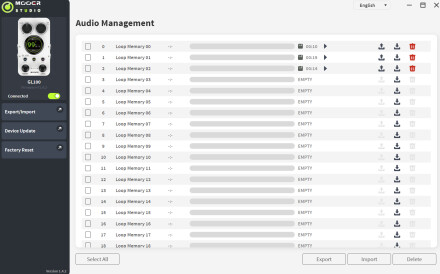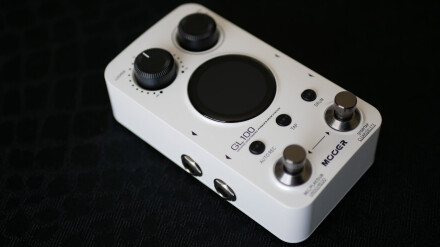With the GL100 Phrase and Drum Station, Mooer offers a looper featuring an intelligent drum machine and some interesting technical features. Let's explore its full potential.

Mooer’s compact looper
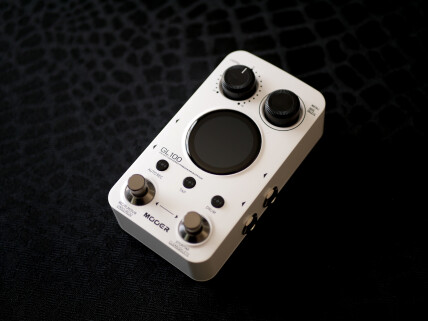
The unit features two inputs and two outputs, all of which are on 6.35mm (1/4-inch) TS jacks, allowing for mono or stereo operation. The main panel includes a 33 mm (1.3-inch) round touch-sensitive color display. Two knobs entitled Looper, and Menu sit at the top of the pedal. The former is a volume control and the latter an encoder for navigating the screen, selecting menu items and initiating storage of loops. Below the screen are three small LED buttons (Auto, Rec, Tap, Drum) and two multi-function footswitches for classic looper controls.
On the top edge is a 3.5 mm (1/8-inch) stereo mini-jack headphone output, a USB-C port and the power socket for the included 9V DC supply. If you plan to use the GL100 on a pedalboard with a power supply, the latter must be capable of delivering 9V and at least 300mA.
The GL100 is manufactured in China, and its assembly quality appears quite satisfactory. At the time of writing, the retail price is €129 ($125).
The unit I tested featured firmware version 1.4.2.
GL100, a looper with a comprehensive feature set
User-interface-wise, the GL100 is not as streamlined a looper as, for example, a TC Electronic Ditto 2. Allow yourself some time to become comfortable with its range of features. To help with navigation, the display offers handy visual feedback to indicate which slot you’re in (100 memories for a total of 300 minutes of recording) and to guide you through the various features. The menu allows you to set quite a few things:
- You can choose between a Rec-Play-Du" or Rec-Dub-Play mode.
- A short or long fade-out can be applied when stopping a loop, in place of a clean sound cut.
- The pedal features two inputs and offers the option of either plugging in a stereo source (a multi-effect, stereo reverb pedal, etc.) or summing the two inputs, which can be very handy for, say, plugging in two instruments. However, one can also envision a configuration with two instruments and two amplifiers. In short, there’s a good deal of connection flexibility.
- When using the built-in drum machine, it’s possible either to send a stereo signal split over the two outputs, or to split the signal in two: the loop alone on the left, the drum machine on the right.
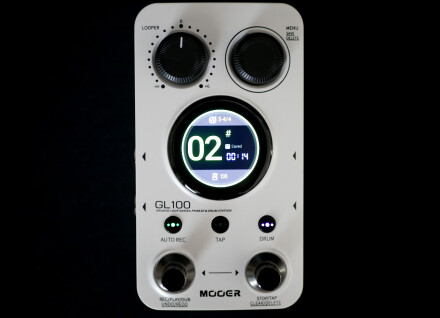
The functions are well-distributed: the left-hand footswitch starts the loop and its recording, and also allows you to delete the last track recorded (Undo) or recall it (Redo). The right footswitch stops the loop, deletes everything, activates the drum machine and acts as a tap tempo. Incidentally, the latter can be fine-tuned using the encoder.
These footswitches also offer the option to navigate between memories while a loop is playing. The following loop starts as soon as the first ends. This feature allows for some interesting, creative possibilities.
Mooer has also taken into account the problems that can arise when using a looper and has integrated several functions to make the process easier. For example, there’s a basic but effective countdown to help anticipate recording. The looper also takes into account the fact of “badly finishing” a measure. Another helpful function is Auto Rec. When activated, the pedal starts recording the moment the strings are touched. There’s also a threshold setting to avoid off-key triggers.
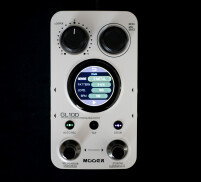
Listen to a few loops:

- 1 – Loop 1 – Drum Pop00:31
- 2 – Loop 2 – Drum Fusion00:55
- 3 – Loop 3 – Drum Metal00:38
Also handy is the Time Stretch function, which lets you change the tempo of a sequence without altering the key. It works well for changes of a few BPM in either direction. As you’d expect with this type of feature, though, extreme tempo alteration can degrade the audio quality.

One feature I was not impressed with was the intelligent/AI Band function called Drum Match, which promises to generate a drum loop tailored to what you’ve just played. I tried it dozens of times (with and without a metronome), sometimes simplifying my loop as much as possible: the result was always shaky. It was almost as if the AI misinterpreted the placement of what was being played. However, the idea isn’t bad, and the type of pattern generated is quite relevant, as it follows the mood of the loop by adapting the style. It’s more a matter of timing that the execution is haphazard. This is all the more unfortunate, as the firmware changelog for 1.4.2 mentions optimization at this level.
The GL100 and its software
The looper features a USB-C port for connection to the "Mooer Studio for GL100” software (Mac/PC). The latter, available on the brand’s website, notably enables updating the pedal’s firmware (which I highly recommend, as the original 1.3.6 version generates some strange bugs) and managing memories. You can use it to listen to a loop, export one, or import an audio file into one of the slots.
It’s a shame, however, that the loops loaded into the software don’t include the output of the drum machine. It would have been nice to have the option to choose whether to include the drums in the export.

